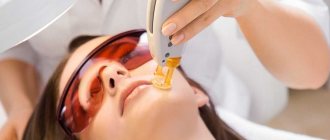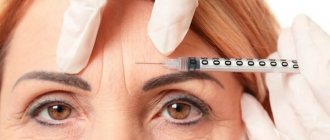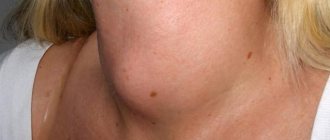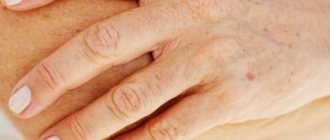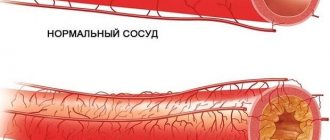Dark spots - These are dark spots whose shades vary from light brown to dark brown. They appear for several reasons, including: the effects of sunburn, age-related changes, abuse of cosmetics, hormonal changes, side effects from medications.
Typically, age spots are considered an aesthetic defect. In most cases, age spots cause dry skin, increased wrinkles and dilated blood vessels. Although age spots are not malignant neoplasms, they serve as an excellent camouflage for the latter (since it is almost impossible to see a neoplasm in the area of an age spot with the naked eye).
Many people try in different ways to get rid of age spots , in this article we will look at: types of age spots, methods of getting rid of them, the need to consult a doctor (in this case an endocrinologist), the effectiveness of procedures and contraindications.
- Exposure to ultraviolet rays
- Using phototherapy
- Indications
Types of pigmentation and age spots
Dermatologists distinguish two types of pigment disorders:
- Type 1: Cutaneous, affects the top layer of skin.
- Second type: Epidermal, disorders in the deep layers of the skin.
The first type of pigmentation is much easier to solve. With proper treatment, the marks disappear after a couple of months.
Freckles
These spots are completely harmless. This is an aesthetic flaw that many even like. They most often appear on light skin under the influence of ultraviolet radiation. Freckles appear on the surface of the skin and are easily removed using cosmetic procedures (for example, chemical peeling). How many of these procedures will be needed depends on the condition of the client’s skin.
Nevi
Moles, called nevi, are highly pigmented areas associated with benign growths on the skin. These congenital spots are divided into two categories:
- Limited focal dysplasia is a disorder of peripheral nerve development. It is characterized by a change in the appearance and color of the dermis around the problem area.
- Focal proliferation of melanin cells is benign (nevoid tumor).
It is important to monitor moles that are located in areas of constant friction (back, groin, armpits) or on open areas of the body. Doctors advise removing moles from such places in a timely manner so as not to damage them. If you experience changes in the area of the spot, you should immediately consult a doctor.
If you are watching:
- Soreness
- Color change
- The appearance of satellites (moles around the “mother”)
- Changes in the structure of the educational sector
- Bleeding; Increase in size
- Itching
These symptoms indicate the beginning of degeneration. Only an oncologist can decide whether to remove moles or not; touching some of them is strictly prohibited. Burning moles with anything at home or in a beauty salon is strictly prohibited. Such actions can cause ultra-rapid tumor growth. All actions with moles are carried out only after receiving the biopsy result. And only an oncologist surgeon can perform such operations.
Chloasma
This type of pigmentation is most typical for women. Chloasma is uneven growths. Chloasma can affect most of the body and almost blend into the skin tone. Most often, such darkening is concentrated on the surface of the face, on the neck or ears. They very rarely reach the forearms and chest.
Chloasma appears against the background of hormonal disorders in women:
- While taking hormonal medications
- In the early days of the cycle
- During menopause
- While pregnant or breastfeeding
In most cases, such defects disappear on their own after the birth of a child or after completing a hormonal course of therapy.
Melasma
It develops according to disorders similar to chloasma - against the background of hormonal imbalances in the body. Uneven grayish or dark brown, usually located symmetrically to each other. The defect increases under the influence of ultraviolet radiation.
Diseases are caused by the following disturbance factors:
- thyroid gland
- gastrointestinal tract
- liver
- gonads
- pituitary gland
In women, spots disappear when hormone levels in the body normalize. In men they rarely turn pale because... are formed in youth.
Lentigo
This is age-related pigmentation , but it can appear by the age of forty. Lentigines are round spots of dark brown or tan color that protrude above the surface. The manifestation is associated with a natural slowdown in metabolism. In females, such pigmentation is aggravated due to hormonal imbalance during menopause.
They appear on:
- Face
- Brushes
- Neckline areas
- Upper back
Vitiligo
This is a disease, the main indicator of which is white pigment spots on the body of different sizes. It most often occurs in young people under the age of 20, but can appear at any age. These spots appear on different parts of the body.
This pathology also disrupts hair pigmentation. The system of development of this disease has not been fully studied, but the cause of this depigmentation has been identified (death or cessation of functioning of cells that produce melanin).
Doctors have identified three types of such pigmentation:
- Generalized is when the white spots are located symmetrically to each other (for example, on two arms or two legs);
- Segmental - affects only one part of the body. Usually appears in young people, progresses in the first year, then stops spreading;
- Localized - manifests itself in single fragments on the body.
Color variation begins on exposed skin on the arms, legs and face and gradually covers the rest of the body. The speed of this process cannot be predicted. Sometimes the spots stop appearing on their own without any treatment and even disappear. But in most cases they cover almost the entire surface of the body. This type of pigmentation develops in people of any skin color, but discolored spots are more noticeable on dark skin.
This disease is not contagious, does not harm health, but significantly reduces the quality of life due to the development of complexes in humans.
Expected effect and duration
To treat pigmentation, you need high-quality diagnostics and a set of measures that suits you. Pigment spots are at different levels of depth, so it is important to choose the appropriate procedures correctly. And the sooner you contact a specialist, the easier it will be to get rid of the problem.
The listed cosmetic measures are universal and have a long-lasting effect. They will give the skin radiance, eliminate pigmentation and wrinkles, prevent the appearance of new spots, and restore firmness and elasticity.
But it should be remembered that pigmentation can not only appear on its own (due to age and exposure to sunlight), but also be a symptom of a disease. Therefore, in the second case, it is important to eliminate the root cause of the stains.
The duration of action for all cosmetic procedures is different: with hardware and injection techniques, the effect will last up to a year, and after thread lifting you can count on several years without insidious spots.
Reasons for the formation of age spots
Often, the appearance of age spots is influenced by: exposure to ultraviolet radiation on the skin, disruption of internal organs, hereditary pigmentation, skin trauma, hormonal and age-related changes. Let's take a closer look at each of them.
Exposure to ultraviolet rays
In most cases, the main reason is exposure to ultraviolet radiation. The sun is the main reason for their appearance. Even if this problem is genetically programmed, ultraviolet rays will be the trigger that will reveal these defects faster.
Ultraviolet radiation, affecting the skin, causes protective reactions against damage, which provoke the activity of melanocytes (they produce pigment). Melanocytes quickly produce melanin. Moreover, it spreads unevenly, especially in places of severe ultraviolet damage. As a result, spots appear on the protruding parts of the face (on the nose and cheekbones), which begin to darken with age.
Disruption of internal organs
There are cases that spots appear from a disease and this is not a cosmetic defect. In this case, it is impossible to get rid of it if the underlying pathology is not eliminated.
The most common diseases of internal organs with skin hyperpigmentation:
- During hypertension, spots appear around the eyes
- Pigmentation appears in the mouth due to the liver
- In the nose area for heart pathologies
- On the chin due to endocrine disorders
- Pigment spots in men and women indicate circulatory disorders due to diabetes mellitus or arteriosclerosis
- Pigment spots in the groin area (genital diseases and fungal infections)
It is impossible to make a diagnosis based only on detecting in which part of the body the pigmentation appeared. If you have dermatological problems, contact your doctor immediately and get examined.
Hereditary pigmentation
In the case of genetic pigmentation, traces of freckles or moles often form not due to defective melanocytes, but in places where they are naturally enriched. Ultraviolet light activates cells and ephelides appear. Each person can have a similar genetic makeup, but it most often occurs in very fair-skinned people (blonds and redheads).
Skin injuries
The area of injury may develop post-traumatic discoloration, scratches, or pimples. This is part of the body's defense response, which activates the production of melanin. This darkening will take a long time to correct. Additionally, the use of bleach in this situation is prohibited. They increase inflammation and therefore increase the immune response. The dimming will only get worse.
Hormonal changes
The skin reacts violently to any changes in hormone levels. In women, this level is less stable due to the characteristics of natural processes in the body. The sensitivity of the epidermis to external irritants increases due to an imbalance in the production of progesterone and esterogen.
Appears in the process:
- Breastfeeding
- Climax
- Puberty
- Carrying a child
- Menses
At the end of pregnancy, the load on a woman’s internal organs increases, which also negatively affects the condition of the skin. So-called liver spots appear on the body.
Age-related changes
Pigment spots occur in older people. Their formation is mainly associated with a slowdown in metabolic processes in the body. Older people have endocrine disorders. In women, menopause is a major risk factor. The second reason is thinning of the skin. Because of this, melanocytes practically rise from the deep layers.
Side effects of medications
Some medications can cause your face to dry out after a sunburn. This occurs if the drug has a photosensitizing effect, that is, it significantly increases sensitivity to ultraviolet radiation.
Side effects may occur from taking the following types of medications:
- Medicines for hypertension and heart failure (clothiazide)
- Medicines for rheumatoid arthritis (azulfidine)
- Antidepressants (melipramine)
- Oral contraceptives
Also, burns may occur at the site of marks on the body, followed by hyperpigmentation.
Removing pigment spots
The most effective and fastest ways to eliminate age spots are offered by beauty salons. The most popular procedures in this area are laser removal of age spots, phototherapy, cryotherapy, chemical and ultrasound peeling and mesotherapy.
Phototherapy
Phototherapy is a procedure for removing age spots of any size, color and texture. The method is one of the most effective in combating discoloration from various sources. Broadband pulsed light acts on the necessary target cells: oxyhemoglobin and melanin.
Unlike laser treatments and chemical peels, all other components of the skin are not damaged. Removal by phototherapy is indicated for the following types of spots:
- Melasma
- Chloasma
- Lentigo
- Keratomas
- Post-traumatic hyperpigmentation (for example, caused by chemical peels in sunny seasons)
- Freckles (partially)
The phototherapy procedure can get rid of stagnant age spots on the face after acne, infiltrates, wounds and cuts. Sometimes one procedure is enough to significantly lighten age spots. If the spots are too large and too colorful, the doctor may prescribe a course of three to five sessions.
Long-term phototherapy regimens are also relevant for those who pursue the following goals:
- Skin thickening and tightening
- Narrowing and smoothing of skin relief
- Elimination of vascular forms
- Refreshing complexion
Phototherapy is not currently the best solution for removing age spots.
Cryotherapy
Helps completely eliminate unwanted pigmentation, warts and various formations. Cryotherapy or freezing can only be performed by a qualified specialist with medical education.
There may be some mild discomfort during the procedure , but no anesthesia is required as the sensations are tolerable. If the pain does not go away after the procedure, you can use painkillers. Very rarely, the procedure for removing age spots with nitrogen leads to swelling of the lower extremities and the appearance of large blisters. This is a short-term phenomenon that quickly disappears.
Chemical peeling
Used to renew skin over large areas. This procedure is based on the effect on the upper layers of the epithelium using special chemicals. Chemical peeling is one of the most effective products designed specifically for removing stains:
- eliminates pigmentation
- removes scars and small scars
- brightens the skin and eliminates freckles
The disadvantages of chemical peeling include the risk of complications , including redness of the skin, allergic reactions and the occurrence of dermatological diseases. This should not be done during pregnancy and breastfeeding, in the presence of non-healing rashes, skin ulcers and in people with epilepsy.
Ultrasonic peeling
A unique procedure that allows you to restore youth and purity of your skin after the first session. This is done using mineral water or ultrasound. Both options are completely painless. The main advantage is that one session is enough to remove small pigments. If necessary, the process can be repeated after 2 weeks. Not recommended for neuralgia, tumors, pregnancy and the postoperative period.
Mesotherapy
The mesotherapy technique was developed in the middle of the last century by French doctors. Features of the procedure:
- Treatment involves introducing various biologically active substances into the body through injections.
- The choice of suitable substances is decided by the cosmetologist.
- They are based on vitamin complexes, amino acids and active substances for certain molecules.
- The downside is that the first effects do not appear immediately.
To completely eliminate skin pigmentation, up to 15 sessions every 7-10 days will be required. Contraindications: individual intolerance to the selected injection drugs, pregnancy, tendency to epilepsy and allergies.
CONTRAINDICATIONS FOR LASER EXPOSURE
- Taking medications that increase sensitivity to light and sunlight;
- Fresh tan;
- The presence of inflammatory processes in the area of skin that will be subject to laser treatment;
- In cases where aggressive cosmetic procedures (chemical peelings, etc.) have recently been carried out. To remove pigmentation with a laser, in this case you need to wait 2-3 weeks;
- Pregnancy, breastfeeding period;
- Presence of oncological diseases (malignant, benign tumors);
- Stage of exacerbation or decompensation of endocrine, systemic and other diseases accompanied by skin hyperpigmentation.
Choosing a clinic for laser pigmentation removal on the face and body in the current competition and the presence of a lot of low-quality Chinese equipment is a very difficult task. Our clinic has all the capabilities for a successful, very professional comprehensive solution to skin hyperpigmentation problems.
Laser removal of age spots
Laser removal of age spots is considered one of the newest and most effective methods. The principle of laser operation is approximately the same, regardless of skin formation. The pigment spot is irradiated with a light beam of a certain length. The laser beam then damages and destroys the melanin in the cells, creating a lighter spot.
Based on the depth of melanin appearance in the skin, these points are divided into:
- epidermal (superficial) dermal (located deep in the skin)
- epidermal-skin spots (mixed)
Indications
The indication for laser removal is the presence of the following formations on the face and other parts of the body:
- spots that appear after sunburn
- epidermal moles (nevi)
- the appearance of pigmentation in wound healing areas
- acne marks
- seborrheic keratosis (numerous superficial papillomatous formations)
- angiomas (cancer) and red spots
- chloasma (excessive pigmentation caused by changes in hormone levels or diseases of the genitourinary system)
- freckles (small pigment spots on the skin ranging from light yellow to light brown)
- Lentil age spots (changes in skin color caused by melanin accumulation)
- pigmented scars (except keloids)
It should be noted that currently there are several methods for correcting skin imperfections: chemical peeling, mesotherapy, cryopilling, etc. However, they act superficially, only partially removing pigments and promoting cell regeneration. The clinic specialist will definitely come to the conclusion that the laser removal procedure for pigment spots is necessary when the methods described above are not enough.
This cosmetic procedure is a skin intervention. Although the complexity of the procedure and subsequent recovery period does not require hospitalization, it is classified as a surgical procedure. In this regard, there are several contraindications.
Advantages
The justification for the cost of this procedure is explained by the following advantages:
- The light works specifically, removing only the necessary pigmented areas
- The duration of the procedure is short
- Skin disinfection occurs when the laser destroys bacteria
- Simultaneous cauterization of the wound, stopping bleeding and preventing the development of infection
- A rejuvenating effect is achieved due to the fact that the skin becomes firm and elastic
- Non-contact (the specialist’s hands do not touch the treated area)
- No pain after laser treatment, therefore, there is no need for painkillers
- There is no risk of further inflammation, so the recovery period will not be long in coming
- The risk of other side effects is minimal
The use of anesthetics is possible if the area being lasered is large or if the pigment is deep enough in the skin.
Preparation for the procedure
The effectiveness of the procedure depends on the preparatory stage, which begins with a visit to a specialist. The dermatologist will select the necessary procedure for removing age spots, taking into account the client’s health profile and skin characteristics. The number of sessions to achieve the desired result is also determined, which can be adjusted during the procedure.
At this point, it is clear how much the planned change will cost in total. It should be noted that planned gradual removal of pigmentation in this area can take a long time, since a repeat session is possible after three months.
Until the prescribed procedure is completed, you can follow these tips:
- do not sunbathe or visit a solarium
- do not thoroughly cleanse the skin; do not drink alcohol and tobacco
Pigmentation can be removed using different types of lasers:
- fractional
- alexandrite
- neodymium
- diode
The presented lasers have a targeted effect and act only on the pigmented area. Healthy skin is not affected.
Fractional laser is preferred because its light beam vaporizes melanin through microscopic damage. One beam per square centimeter is capable of distinguishing up to 1,100 areas, penetrating to a depth of 1.5 millimeters.
The neodymium laser is different in that it heats melanin and oxyhemoglobin. This means that it can also be used to remove vascular formations. It is quite powerful and penetrates deeply into the skin.
The list does not include a rarely used type of laser - ruby. Laser removal of pigment spots using a ruby laser is rare because it does not differentiate cells with normal and high melanin content well enough. Used very rarely and on very fair skin. Do not use on dark skin to avoid exposing unwanted areas.
How is the laser pigment spot removal procedure performed?
The laser operation consists of many short flashes of light, which may be accompanied by loud noise. The laser beam is dangerous for the organs of vision, so the specialist and the customer wear glasses during the procedure.
The procedure is gradual and is performed according to the following scheme:
- The skin is cleansed (makeup removal, antiseptic treatment).
- A product is applied to the area to ensure deep penetration of the rays into the skin.
- The specialist applies the laser to the selected area.
- The surface of the skin is treated with an antiseptic.
- A sterile bandage or bandage is applied to the area of skin to allow for further healing.
Redness and swelling may appear immediately after the procedure, which lasts about a day. The wound itself becomes covered with a crust, which disappears after 5 days. You should not touch it or remove it yourself, as in this case a scar may form. Once the scab completely melts, it makes room for new, healthy cells containing normal levels of melanin.
Sometimes the specialist performing the procedure suggests using a product, usually panthenol. The use of decorative cosmetics in this area is prohibited.
Restrictions after the procedure
For about a week after laser skin lightening, you should not swim in the pool or open water, you should also avoid exposure to direct sunlight, and you should not visit the solarium. Aggressive types of influence (peelings, scrubs) should also be avoided.
To make an appointment for laser skin whitening in Moscow, call us by phone or fill out the form on the website. Experienced cosmetologists at our center will help you choose the optimal care program for you and recommend medicinal cosmetics for home use.
Which method of removing age spots should I choose?
Modern cosmetology offers a wide selection of products and techniques for restoring a uniform and radiant complexion. How to remove pigment spots should be decided by the doctor after a preliminary examination of the patient. Self-administration of aggressive drugs can cause the development of difficult-to-treat side diseases that aggravate chronic diseases.
At the moment, the most effective method is laser removal of age spots. The main reasons for this choice are a less painful procedure, a quick and predictable result, the absence of foreign bodies in the skin tissue (unlike injection methods), and quick rehabilitation (thanks to a gentle regimen).
If you can’t decide on a method for removing age spots, start with laser.
